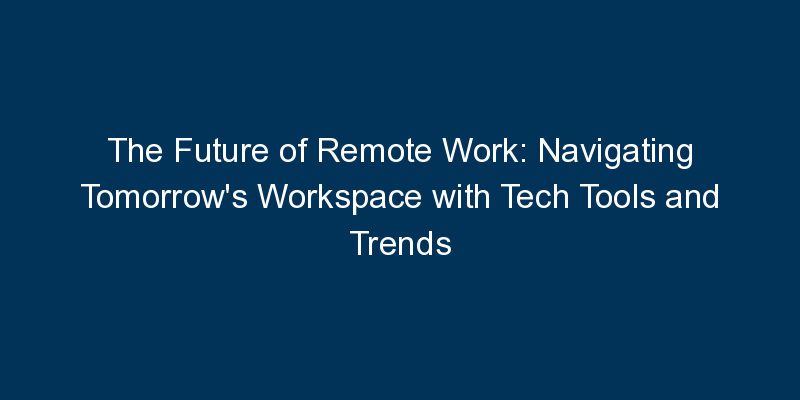Introduction
The landscape of work is undergoing a revolutionary shift, with remote work emerging as a pivotal trend. This blog delves into the future of remote work, exploring the tech tools and trends that are shaping the way we collaborate, communicate, and redefine the traditional office environment.
The Remote Work Revolution
1. Defining Remote Work in the Digital Era
Remote work involves the ability to perform tasks from anywhere, leveraging digital technologies to stay connected and productive. The adoption of remote work has accelerated, driven by advancements in technology and a shift in the way we approach work-life balance.
2. The Role of Technology in Enabling Remote Work
Technology is the linchpin of remote work, facilitating seamless communication, collaboration, and task management. From video conferencing to project management tools, a plethora of technologies empowers remote teams to work efficiently.
Tech Tools Transforming Remote Collaboration
3. Video Conferencing Platforms for Virtual Meetings
Video conferencing has become the cornerstone of remote collaboration. Platforms like Zoom, Microsoft Teams, and Google Meet enable face-to-face interactions, fostering team cohesion and maintaining a sense of connection.
4. Collaboration and Project Management Tools
Tools such as Slack, Asana, and Trello streamline collaboration by providing centralized platforms for communication, task assignment, and project tracking. These tools enhance efficiency and organization in a virtual workspace.
5. Cloud-Based Document Collaboration
Cloud-based document collaboration platforms like Google Workspace and Microsoft 365 allow teams to work on documents in real-time, fostering seamless collaboration regardless of physical location.
Trends Shaping the Future of Remote Work
6. Virtual and Augmented Reality in Remote Collaboration
The integration of virtual and augmented reality is a rising trend. These technologies provide immersive experiences, enabling remote teams to collaborate in virtual environments and conduct virtual meetings with a heightened sense of presence.
7. Artificial Intelligence (AI) for Enhanced Productivity
AI-driven tools enhance productivity by automating repetitive tasks, providing data insights, and offering personalized assistance. Virtual assistants and AI-powered analytics contribute to a more streamlined remote work experience.
8. The Rise of Hybrid Work Models
Hybrid work models, combining remote and in-office work, are gaining popularity. This approach offers flexibility and allows employees to choose a working environment that suits their preferences and tasks.
Challenges and Considerations
9. Digital Fatigue and Wellbeing
The constant use of digital tools can lead to digital fatigue. It is essential for organizations to prioritize employee wellbeing by encouraging breaks, implementing flexible schedules, and fostering a healthy work-life balance.
10. Cybersecurity in a Decentralized Workspace
As remote work expands, the importance of cybersecurity becomes paramount. Organizations must invest in robust cybersecurity measures to protect sensitive data and ensure the integrity of remote work environments.
Future Trajectories in Remote Work
11. 5G Connectivity and Seamless Remote Experiences
The rollout of 5G networks will enhance connectivity, enabling faster and more reliable remote work experiences. This trend will facilitate smoother video conferencing, quicker file transfers, and overall improved virtual collaboration.
12. Continuous Evolution of Remote Work Policies
Remote work policies will continue to evolve. Organizations will need to adapt policies to accommodate changing employee needs, foster inclusivity, and create a supportive remote work culture.
Conclusion
The future of remote work is dynamic, with technology at its core, driving innovation and redefining the traditional office paradigm. As organizations embrace the flexibility and efficiency of remote work, the integration of tech tools and adoption of emerging trends will shape the remote work experience.
In navigating the future of remote work, a holistic approach that combines innovative technologies with a focus on employee wellbeing is key. By staying abreast of evolving trends, leveraging advanced tech tools, and fostering a culture of adaptability, organizations can not only navigate the remote work landscape but also thrive in the digital workspace of tomorrow.

















Comments